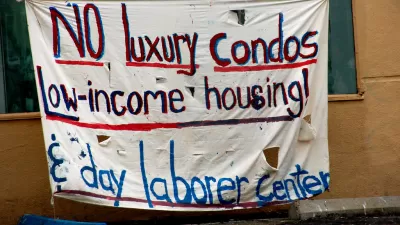While most Bay Area communities are pursuing housing solutions "individually," local planners acknowledge the need for strategies that address the regional as a unified whole.

"Though each of the Bay Area's nine counties and 101 cities is experiencing the region's housing crisis differently, the message from local planners is unified and clear: the problem demands a regional solution," Emma Zehner writes for the Lincoln Institute.
Discussing a meeting of eight Bay Area planning directors at this spring's annual APA conference, Zehner writes that as certain places (like San Francisco) add jobs at a breakneck pace, "other cities in the region are beginning to step up to create new regional job centers where housing is more readily available or where there is still the flexibility to add additional units."
San Jose, for instance, "has significant untapped housing potential as 94 percent of its residential land is currently zoned for detached single-family homes." At the same time, "San Jose faces a different type of imbalance: only nine percent of the city's land is devoted to employment uses." A new jobs center in San Jose could relieve pressure on San Francisco. So could locating more jobs in Oakland.
The planners acknowledged that even as job centers grow, the housing issue also depends on transportation. "If we could get to and from job centers more efficiently, it could solve some very significant problems for us," said Al Savay, community and economic development director for San Carlos.
Also discussed were ADU regulatory reform, inclusionary zoning, and potential for overarching state legislation.
FULL STORY: Housing Affordability: Regional Strategies to Address the Bay Area Affordability Crisis

Study: Maui’s Plan to Convert Vacation Rentals to Long-Term Housing Could Cause Nearly $1 Billion Economic Loss
The plan would reduce visitor accommodation by 25,% resulting in 1,900 jobs lost.

North Texas Transit Leaders Tout Benefits of TOD for Growing Region
At a summit focused on transit-oriented development, policymakers discussed how North Texas’ expanded light rail system can serve as a tool for economic growth.

Why Should We Subsidize Public Transportation?
Many public transit agencies face financial stress due to rising costs, declining fare revenue, and declining subsidies. Transit advocates must provide a strong business case for increasing public transit funding.

How to Make US Trains Faster
Changes to boarding platforms and a switch to electric trains could improve U.S. passenger rail service without the added cost of high-speed rail.

Columbia’s Revitalized ‘Loop’ Is a Hub for Local Entrepreneurs
A focus on small businesses is helping a commercial corridor in Columbia, Missouri thrive.

Invasive Insect Threatens Minnesota’s Ash Forests
The Emerald Ash Borer is a rapidly spreading invasive pest threatening Minnesota’s ash trees, and homeowners are encouraged to plant diverse replacement species, avoid moving ash firewood, and monitor for signs of infestation.
Urban Design for Planners 1: Software Tools
This six-course series explores essential urban design concepts using open source software and equips planners with the tools they need to participate fully in the urban design process.
Planning for Universal Design
Learn the tools for implementing Universal Design in planning regulations.
City of Santa Clarita
Ascent Environmental
Institute for Housing and Urban Development Studies (IHS)
City of Grandview
Harvard GSD Executive Education
Toledo-Lucas County Plan Commissions
Salt Lake City
NYU Wagner Graduate School of Public Service





























